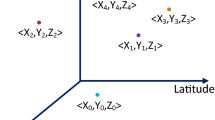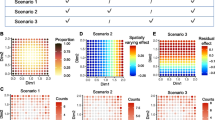Abstract
Spatial interactions are key determinants in the dynamics of many epidemiological and ecological systems; therefore it is important to use spatio-temporal models to estimate essential parameters. However, spatially-explicit data sets are rarely available; moreover, fitting spatially-explicit models to such data can be technically demanding and computationally intensive. Thus non-spatial models are often used to estimate parameters from temporal data. We introduce a method for fitting models to temporal data in order to estimate parameters which characterise spatial epidemics. The method uses semi-spatial models and pair approximation to take explicit account of spatial clustering of disease without requiring spatial data. The approach is demonstrated for data from experiments with plant populations invaded by a common soilborne fungus, Rhizoctonia solani. Model inferences concerning the number of sources of disease and primary and secondary infections are tested against independent measures from spatio-temporal data. The applicability of the method to a wide range of host-pathogen systems is discussed.
Similar content being viewed by others
References
Bolker, B. and S. W. Pacala (1997). Using moment equations to understand stochastically driven spatial pattern formation in ecological systems. Theor. Popul. Biol. 52, 179–197.
Bonabeau, E., L. Toubiana and A. Flahault (1998). The geographical spread of influenza. Philos. R. Soc. Lond. B Biol. 265, 2421–2425.
Campbell, C. L. and L. Madden (1990). Introduction to Plant Disease Epidemiology, New York: Wiley-Interscience.
Clark, J. S. et al. (2001). Ecological forecast: an emerging imperative. Science 293, 657–660.
Dieckmann, U., R. Law and J. A. J. Metz (Eds), (2000). The Geometry of Ecological Interactions: Simplifying Spatial Complexity, Cambridge: Cambridge University Press.
Diggle, P. J. (1983). Statistical Analysis of Spatial Point Patterns, London: Academic Press.
Diggle, P. J. (1996). Time Series: A Biostatistical Introduction, Oxford: Oxford Science Publications.
Earn, D. J. D., J. Dushoff and S. A. Levin (2002). Ecology and evolution of the flu. Trends Ecol. Evol. 17, 334–340.
Ellner, S. P., A. Sasaki, Y. Haraguchi and H. Matsuda (1998). Speed of invasion in population models: pair-edge approximation. J. Math. Biol. 36, 469–484.
Everitt, B. S. (1998). Dictionary of Statistics, Cambridge: Cambridge University Press.
Ferguson, N. M., A. C. Donelly and R. M. Anderson (2001). The foot-and-mouth epidemic in Great Britain: pattern of spread and impact of interventions. Nature 292, 1155–1160.
Filipe, J. A. N. and G. J. Gibson (1998). Studying and approximating spatio-temporal models for epidemic spread and control. Philos. Trans. R. Soc. B 353, 2153–2162.
Filipe, J. A. N. and G. J. Gibson (2001). Comparing approximations to spatio-temporal models for epidemics with local spread. B. Math. Biol. 63, 603–624.
Filipe, J. A. N. and M. M. Maule (2003a). Analytical methods for predicting the behaviour of population models with general spatial interactions. Math. Biosci. 183, 15–35.
Filipe, J. A. N. and M. M. Maule (2003b). Effects of dispersal mechanisms on spatio-temporal development of epidemics. J. Theor. Biol. (in press).
Freckleton, R. P. (1999). Biological control as a learning process. Trends Ecol. Evol. 17, 263–264.
Freeman, E. A. and E. D. Ford (2002). Effects of data quality on analysis of ecological pattern using the K(d) statistical function. Ecology 83, 35–46.
Gibson, G. J. (1997). Investigating mechanisms of spatio-temporal epidemic spread using stochastic models. Phytopathology 87, 139–146.
Gibson, G. J., C. A. Gilligan and A. Kleczkowski (1999). Predicting variability in biological control of a plant-pathogen system using stochastic models. Philos. R. Soc. Lond. B Biol. 266, 1743.
Gilligan, C. A. (1985). Probability models for host infection by soilborne fungi. Phytopathology 75, 61–67.
Gilligan, C. A. (1990a). Antagonistic interactions involving plant pathogens—fitting and analysis of models to nonmonotonic curves for population and disease dynamics. New Phytol. 115, 649–665.
Gilligan, C. A. (1990b). Comparison of disease progress curves. New Phytol. 115, 223–242.
Gilligan, C. A. (2002). An epidemiological framework for disease management. Adv. Bot. Res. 38, 1–64.
Gilligan, C. A. and A. Kleczkowski (1997). Population dynamics of botanical epidemics involving primary and secondary infection. Philos. Trans. R. Soc. B 352, 591–608.
Gottwald, T. R., R. Hughes, J. H. Graham, X. Sun and T. Riley (2001). The citrus canker epidemic in florida: the scientific basis of regulatory eradication policy for an invasive species. Phytopathology 91.
Grenfell, B. T., O. N. Bjornstad and J. Kappey (2001). Travelling waves and spatial hierarchies in measles epidemics. Nature 414, 716–723.
Hastings, A. (1996). Models of spatial spread: a synthesis. Biol. Conserv. 78, 143–148.
Hiebeler, D. (2000). Populations of fragmented landscapes with spatially structured heterogeneities. Ecology 81, 1629–1641.
Jeger, M. J. (Ed.), (1989). Spatial Components of Plant Disease Epidemics, Englewood Cliffs: Prentice Hall.
Keeling, M. J. (1999). The effects of local spatial structure on epidemiological invasion. Philos. R. Soc. Lond. B Biol. 266, 859–867.
Keeling, M. J. et al. (2001). Dynamics of the 2001 UK foot and mouth epidemic: Stochastic dispersal in a heterogeneous landscape. Science 294, 813–817.
Kleczkowski, A., D. J. Bailey and C. A. Gilligan (1996). Dynamically generated variability in plant-pathogen systems with biological control. Philos. R. Soc. Lond. B Biol. 263, 777–783.
Leonard, K. J. and W. E. Fry (Eds), (1986). Plant Disease Epidemiology. Vol. 1: Population Dynamics and Management, New York: Macmillan Publishing Company.
Levin, S. A. and R. Durrett (1996). From individuals to epidemics. Philos. Trans. R. Soc. B 351, 1615–1621.
Lewis, M. A. and S. Pacala (2000). Modelling and analysis of stochastic invasion processes. J. Math. Biol. 41, 378–429.
Ljung, G. M. and G. E. P. Box (1978). On a measure of lack of fit in time series models. Biometrika 65, 297–303.
Matsuda, H., N. Ogita, A. Sasaki and K. Sato (1992). Statistical mechanics of population— the lattice Lotka-Volterra model. Prog. Theor. Phys. 88, 1035–1049.
Mollison, D. (1977). Spatial contact models for ecological and epidemic spread. J. R. Stat. Soc. B 39, 283–326.
Mollison, D. (Ed.), (1995). Epidemic Models and their Relation to Data, Cambridge: Cambridge University Press.
Neubert, M. G. and H. Caswell (2000). Demography and dispersal: calculation and sensitivity analysis of invasion speed for structured populations. Ecology 81, 1613–1628.
Otten, W., J. A. N. Filipe, D. J. Bailey and C. A. Gilligan (2003). Quantification and analysis of transmission rates for soil-borne epidemics. Ecology (in press).
Sakai, A. K. (2001). The population biology of invasive species. Annu. Rev. Ecol. Syst. 32, 305–332.
Sato, K., H. Matsuda and A. Sasaki (1994). Pathogen invasion and host extinction in lattice structured populations. J. Math. Biol. 32, 251–268.
Swinton, J. and C. A. Gilligan (1999). Selecting hyperparasites for biocontrol of Dutch elm disease. Philos. R. Soc. Lond. B Biol. 266, 437–445.
Zadoks, J. and F. van den Bosch (1994). On the spread of plant-disease—a theory on foci. Ann. Rev. Phytopathology 32, 503–521.
Author information
Authors and Affiliations
Corresponding author
Rights and permissions
About this article
Cite this article
Filipe, J.A.N., Otten, W., Gibson, G.J. et al. Inferring the dynamics of a spatial epidemic from time-series data. Bull. Math. Biol. 66, 373–391 (2004). https://doi.org/10.1016/j.bulm.2003.09.002
Received:
Accepted:
Issue Date:
DOI: https://doi.org/10.1016/j.bulm.2003.09.002




